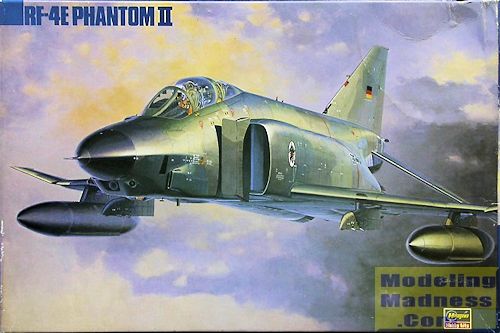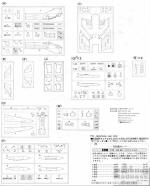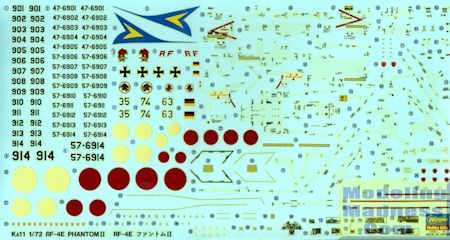
Hasegawa 1/72 RF-4E Phantom II
| KIT #: | 04111 (Ka11) |
| PRICE: | 1800 yen when new |
| DECALS: | Four options |
| REVIEWER: | Scott Van Aken |
| NOTES: | 1991 base issue |

| HISTORY |
The first F-4 model to enter German service was the RF-4E. The Luftwaffe signed a contract with McDonnell Douglas for 88 RF-4Es in 1968; at the time the biggest order outside the USAF. The contract included industrial offsets for German industry, particularly production work for Messerschmitt-Bölkow-Blohm who manufactured and supplied F-4 components to McDonnell Douglas' Phantom production facility in St. Louis.
On 16 January 1971 the first RF-4E, dubbed the "Spirit of St. Louis", flew from the U.S. to Spain and finally onto Germany. The next day, at Bremgarten, the aircraft was accepted by the Inspekteur der Luftwaffe ("Inspector of the Luftwaffe", Gunther Rall.
In 1972, with eight Phantoms per month being delivered, Aufklärungsgeschwader 51 "Immelmann" equipped with the RF-4, followed by AG 52, based at Leck.
The German RF-4E was equipped similarly to the USAF RF-4Cs, using the latest F-4E airframe and more-powerful engines. The RF-4Es were employed as day/night reconnaissance aircraft, equipped with four cameras covering 180 degrees. There were special flares for night use and two night/all-weather reconnaissance systems. One was the IRRS (Infrared Recognition System) and the other was the SLAR (Side-Looking Airborne Radar), mounted in the side of the fuselage. The aircraft had the capability to develop photos in flight and then drop them using special cartridges. Missions were generally flown at low level and high speed, using the installed APQ-99 radar for navigation. Deliveries were completed in May 1972 and the previously employed RF-104Gs were modified to serve in strike or fighter units.
Another user of new RF-4Es was Japan. Fourteen RF-4Es were delivered between November 1974 and June 1975. These were similar to the RF-4C, but, as for the F-EJs, Japanese-built radar warning receivers and other equipment were substituted to replace equipment which was not released for export to Japan. These aircraft were replaced by pod-carrying F-4EJkai aircraft when the RF-4Es were taken out of service.
| THE KIT |
 Back
in the late 1980s and early 1990s, Hasegawa embarked on a program of F-4 Phantom
II kits. This would be the third time they did new molds of this aircraft, their
initial kit being a very
crude F-4J that could also be done as an initial production
F-4D and only came with generic markings and is best left to collectors. Their
second offering was pretty much a gun Phantom that was done in several boxings
including an F-4E, F-4F and F-4EJ. This one wasn't all that bad and though not
at all up to modern standards, does build into a fairly nice model. I have built
several, the last one being a
stand model.
Back
in the late 1980s and early 1990s, Hasegawa embarked on a program of F-4 Phantom
II kits. This would be the third time they did new molds of this aircraft, their
initial kit being a very
crude F-4J that could also be done as an initial production
F-4D and only came with generic markings and is best left to collectors. Their
second offering was pretty much a gun Phantom that was done in several boxings
including an F-4E, F-4F and F-4EJ. This one wasn't all that bad and though not
at all up to modern standards, does build into a fairly nice model. I have built
several, the last one being a
stand model.
 Instructions
show four different markings options, but really, there are more. There are
two German planes in the wraparound lizard scheme. These planes differ by
serial number and unit badge as you are provided badges for both AKG 51 and
AKG 52. If you wish to do the earlier splinter scheme, there are aftermarket
decals that have those. The other two options are Japanese and with markings
for the only unit to use it, 501 Squadron. The first option uses the
camouflage scheme that I used on
this 1/48 build. Serial numbers for all 14
aircraft are provided. The other is for the initial delivery batch in light
gull grey over white with the large fin markings and only one serial option.
You also get a ton of stencils, but fortunately, Hasegawa has done these in
such a way that many in the same area are on the same carrier. These are
'old school' Hasegawa decals where they are a bit thick, will require very
hot water to work properly, and have white bits that are actually off-white.
Instructions
show four different markings options, but really, there are more. There are
two German planes in the wraparound lizard scheme. These planes differ by
serial number and unit badge as you are provided badges for both AKG 51 and
AKG 52. If you wish to do the earlier splinter scheme, there are aftermarket
decals that have those. The other two options are Japanese and with markings
for the only unit to use it, 501 Squadron. The first option uses the
camouflage scheme that I used on
this 1/48 build. Serial numbers for all 14
aircraft are provided. The other is for the initial delivery batch in light
gull grey over white with the large fin markings and only one serial option.
You also get a ton of stencils, but fortunately, Hasegawa has done these in
such a way that many in the same area are on the same carrier. These are
'old school' Hasegawa decals where they are a bit thick, will require very
hot water to work properly, and have white bits that are actually off-white.| CONCLUSIONS |
So there it is, another fine addition to the Hasegawa Phantom family. From the look of the sprues, you could do a USAF RF-4C using this particular kit. I only mention this as the Hasegawa RF-4C kit is not all that easy to find and the RF-4E kit is not considered as desirable. This means that if you have aftermarket RF-4C markings you want to use and can only find the RF-4E kit, you are probably going to be in luck.
| REFERENCES |
http://en.wikipedia.org/wiki/McDonnell_Douglas_F-4_Phantom_II_non-U.S._operators
January 2015 Thanks to your editor for the preview kit. If you would like your product reviewed fairly and fairly quickly, please
contact
the editor or see other details in the
Note to
Contributors.